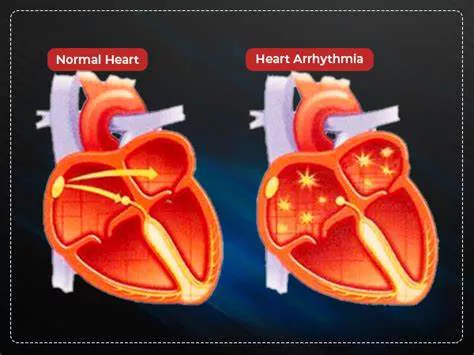Arrhythmia, a term that sparks concern for many, refers to any change from the normal sequence of electrical impulses, causing abnormal heart rhythms. These rhythms can be too fast, too slow, or irregular, leading to potentially serious health implications if left unchecked. The heart’s electrical system orchestrates the timing of the heartbeats. When this system is disrupted, it can result in a variety of arrhythmias, each with unique characteristics and potential consequences.
Types of Arrhythmia
Arrhythmias are primarily categorized based on the speed of heartbeats: tachycardia (fast heartbeats), bradycardia (slow heartbeats), and atrial fibrillation (irregular heartbeats). Each category is further divided based on where they originate in the heart (atria or ventricles).
See Also: Can Blood Clot Cause Arrhythmia
1. Tachycardia
Tachycardia refers to a heart rate that exceeds the normal resting rate. Generally, in adults, a heart rate of over 100 beats per minute (BPM) is considered tachycardic. Tachycardias are further classified into several types, including:
Supraventricular Tachycardia (SVT)
SVT originates above the ventricles, specifically in the atria or the AV node, which acts as an electrical relay station between the atrial and ventricular chambers. Common forms of SVT include Atrial Flutter, Atrial Fibrillation, and Paroxysmal Supraventricular Tachycardia (PSVT).
Atrial Fibrillation (AFib): The most common type of serious arrhythmia, AFib involves a chaotic rhythm in the atria, resulting from disorganized electrical signals that cause an irregular and often rapid heart rate. AFib is particularly dangerous due to its association with an increased risk of stroke and heart failure.
Atrial Flutter: Similar to AFib, Atrial Flutter is characterized by rapid but regular contractions, generally more organized than those seen in AFib.
Paroxysmal Supraventricular Tachycardia (PSVT): This involves sudden bursts of rapid heart rate that begin and end abruptly.
Ventricular Tachycardia (VT)
Ventricular tachycardia is a rapid heart rhythm that originates with abnormal electrical signals in the ventricles. It can result in rates of 170 beats per minute or more and is a major risk factor for ventricular fibrillation, a leading cause of sudden cardiac death.
Ventricular Fibrillation (VF)
VF is an emergency situation where the ventricles quiver ineffectively instead of pumping due to disorganized electrical activity. This can lead to death within minutes if not treated immediately with defibrillation.
2. Bradycardia
Bradycardia is defined as a slow heart rate, typically under 60 BPM in adults. It can be normal in highly fit individuals but may cause problems if the heart is not pumping enough oxygen-rich blood throughout the body.
Sinus Node Dysfunction
This occurs when the heart’s natural pacemaker, the sinus node, fails to generate signals fast enough to maintain a normal heart rate. It may result in fatigue, dizziness, or fainting spells.
see also: Can Salt Cause Arrhythmia
Heart Block
A heart block occurs when electrical signals are delayed or blocked entirely as they move through the heart. These blocks are categorized into first, second, and third degrees, depending on the severity of the signal delay or blockage.
3. Atrial Fibrillation
Already mentioned under tachycardia, atrial fibrillation deserves a separate discussion for its prevalence and impact. It is characterized by a rapid, irregular heart rate that commonly causes poor blood flow to the body. This condition is a major cause of stroke, especially in the elderly, and requires strategic management including rhythm control, rate control, and anticoagulation.
Diagnosis and Treatment
Diagnosing arrhythmias involves a range of tools including:
Electrocardiogram (ECG or EKG): This is the primary tool for diagnosing rhythm problems by recording the electrical activity of the heart.
Holter Monitor: A portable device worn to record a continuous ECG for 24-48 hours, typically used if the arrhythmia is not captured by a standard ECG.
Event Recorders: Devices used for several weeks to detect occasional arrhythmias.
Electrophysiological Study (EPS): A test where catheters are guided through blood vessels into the heart to study the electrical signals.
Treatment varies by the type of arrhythmia but may include:
Medications: Used to control the heart rate or restore the heart to a normal rhythm.
Pacemaker: A device implanted to regulate the heartbeat.
Cardioversion: An electrical shock to the heart to restore normal rhythm.
Catheter Ablation: A procedure that destroys areas of the heart tissue causing irregular signals.
Implantable Cardioverter Defibrillator (ICD): A device implanted to monitor heart rhythms and deliver shocks if necessary to correct abnormal rhythms.
Prevention and Management
Managing risk factors is crucial in preventing arrhythmias. This includes maintaining a healthy weight, regular physical activity, managing high blood pressure, controlling cholesterol levels, limiting alcohol intake, and avoiding tobacco smoke.
Those with existing heart conditions or a history of arrhythmias should be closely monitored by their healthcare providers to manage their condition effectively.
Conclution
In conclusion, understanding the various types of arrhythmias and their implications is vital for timely and effective treatment. Whether it involves lifestyle adjustments, medication, or more invasive procedures, managing heart rhythm disorders is a crucial aspect of cardiovascular health. With proper care, most individuals with arrhythmias can lead healthy, active lives.

